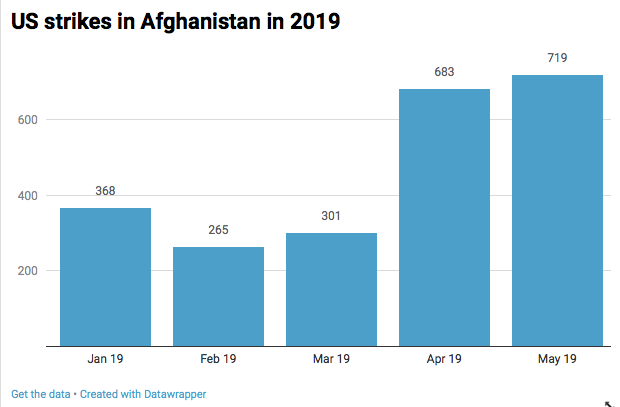June 13, 2019
This month the Bureau of Investigative Journalism published an investigation with the Visual Investigations unit of The New York Times. It followed the story of Masih who lost his wife, all seven of his children and four young relatives in an airstrike on his home in September last year. As grief consumed Masih, so did an intense need for answers – who had killed his family and why?
The US and Afghan militaries – the only two forces carrying out strikes in Afghanistan – both denied responsibility. But we were able to work alongside Masih to find out more, uncovering crucial evidence that the US military, despite numerous denials, had dropped the fatal bomb.
The story highlights what we’ve been seeing for some time. While US and Afghan operations are now killing more civilians than the insurgency for the first time in a decade, getting confirmation of who has carried out a fatal strike is often impossible. An apology, or any form of public accountability, is even harder to obtain.
Shortly before the story was published, the US military finally admitted it had carried out the strike on Masih’s house but it still denies it killed civilians.
Back story:
It was 4am when Masih Ur-Rahman Mubarez’s wife Amina called, an unusually early time for their daily chat. When he picked up the phone, he could hear the panic in her voice.
Amina was calling from the Afghan province of Wardak, where she brought up their children while he worked over the border in Iran to support them. She told him that soldiers were raiding their village. Some of them were speaking English. Amina was told to turn off her phone but Masih asked her not to – how would he know they were ok?
The call ended with Masih saying he would call again when things had calmed. But at 9am, when he dialled his wife’s number, her phone was off. He tried again at 9.30am. Still off. Through the whole of that day and the next, he repeatedly called. But Amina’s phone remained off.
It took another day for him to the learn the truth. Relatives avoided his calls or gave vague replies to his questions, until finally his brother broke the news. “He tried to avoid telling me the whole story, but I insisted that he tell me the truth,” Masih recalled in a wavering voice. “He told me to have patience in God – no one is left.”
An airstrike on Masih’s house had killed his wife and all his seven children, alongside four young cousins. His youngest child was just four years old.
In the following weeks, as grief consumed Masih, so did an intense need for answers. Who had killed his family and why?
His journey to find out would last more than eight months, pit him against military and government officials, and see him face obfuscation and denials. It would lead him to work alongside the Bureau and journalists from The New York Times, putting together a puzzle piece by piece. Ultimately it would lead to one definitive conclusion – the US military had dropped the fatal bomb.
His story is one window into the struggles faced by families across Afghanistan every day. Airstrikes are raining down on the country, with US and Afghan operations now killing more civilians than the insurgency for the first time in a decade. But getting confirmation of who has carried out a fatal strike is often impossible. An apology, or any form of public accountability, is even harder to obtain.
The US denied repeatedly that it had bombed Masih’s house, or even that any airstrike in his area had taken place. But using satellite imagery, photos and open source content, we proved that denial false. Following our investigation, the military has now admitted that it did conduct a strike in that location, but it still denies it resulted in civilian deaths. Continue reading full story.
Strikes in Afghanistan continued at a high pace in May. Below is a chart showing that rise.

May’s figures for strikes in Afghanistan are below:
| Bureau data | Afghanistan |
| Confirmed US strikes: | 719 |
| Total killed: | N/A |
| Civilians reported killed: | N/A |








